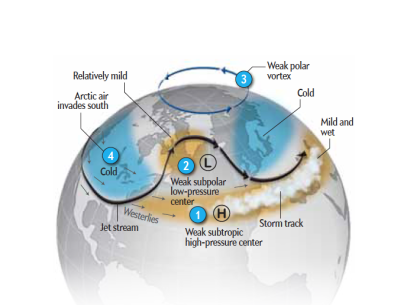Science Source
Arctic impact
- Reviews recent research pertaining to atmospheric links between the poles and midlatitudes
- Reviews prominent theory of Jennifer Francis and Stephen Vavrus that a faster warming Arctic means, (1) a reduced temperature gradient between the Arctic and midlatitudes that weakens west-to-east winds, (2) a slowdown of the jet stream, allowing it to meander more and form elongated waves (called Rossby or planetary waves) that jut to the north or south, and (3) that the deep waves in the jet stream could enable a winter storm to push farther south and then linger in one location, possibly dumping record amounts of snow
- Finds that newer studies support one key part of this hypothesis: that large-amplitude Rossby waves in the jet stream are indeed linked, statistically, to extreme weather in the midlatitudes
- Mentions related theory that dwindling sea ice could shape midlatitude weather by forcing changes in a multiyear atmospheric cycle called the Arctic Oscillation but states that evidence is scarce
Related Content
Headline

Apr 12, 2016 | Scientific American Blog Network
What Is This Polar Vortex That Is Freezing the U.S.?
Science Source
| Journal of Climate
Linking Siberian Snow Cover to Precursors of Stratospheric Variability
Judah Cohen, Jason C. Furtado, Justin Jones et al
Science Source
| Science
The Siberian snow connection
Carolyn Gramling
Science Source
| Nature Geoscience
Recent Arctic amplification and extreme mid-latitude weather
Judah Cohen, James A. Screen, Jason C. Furtado et al


